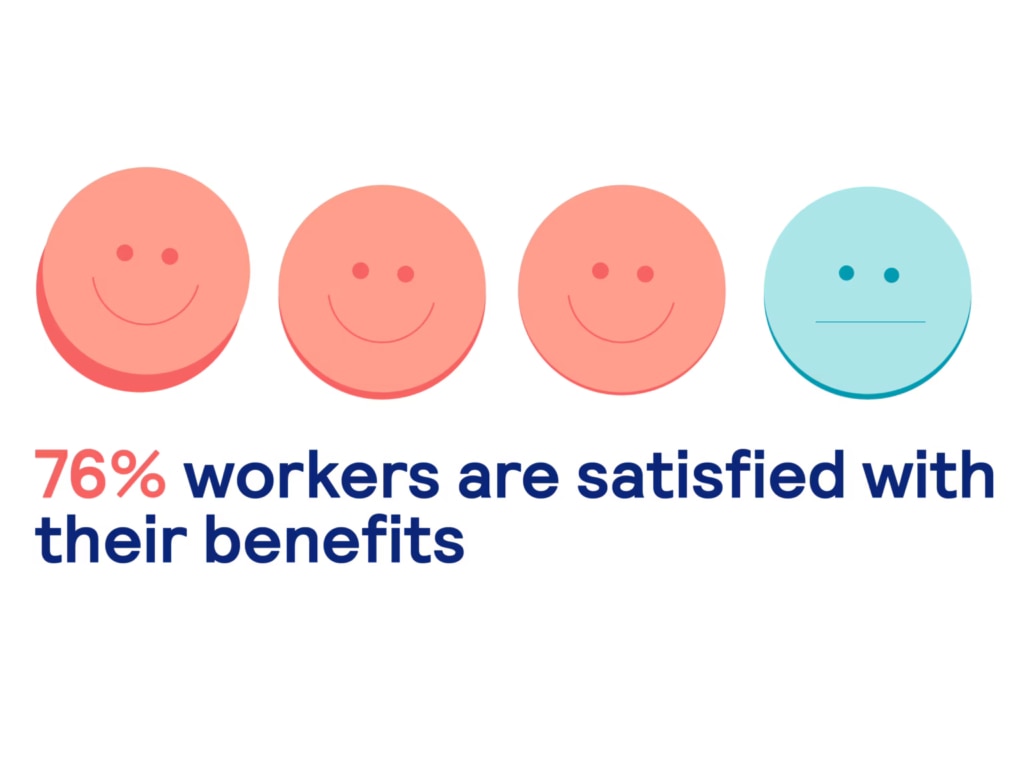
How to create employee benefits packages that can attract and retain top talent
Table of Contents
- What are employee benefits?
- Types of employee benefits
- Most popular employee benefits
- How to build a competitive employee benefits package

UK Salary Trends Report 2025
Employee benefits have become increasingly important for organisations looking to attract and retain talent. Discover how to create a benefits package that stands out in a competitive landscape with the help of our latest research.
Employee benefits play a crucial role in a competitive approach to compensation. While our research reveals that 76% of workers are satisfied with their current benefits, a significant 66% are willing to forgo a pay rise to secure their most sought-after perks.
These findings highlight the importance of crafting a benefits package benchmarked against employee expectations and aligned jobseeker with priorities.
In this guide, we will explore the key components of employee benefits and offer tips for creating a package that resonates with candidates and attracts top talent.
Uncover the latest UK benefit trends to ensure your offering hits the mark

UK Salary Trends Report 2025
What are employee benefits?
Employee benefits are the incentives in an employer’s compensation offering to staff and prospective candidates outside of their salary. These can include both monetary and non-monetary rewards.
While a benefits package might include components employers are legally required to offer, such as paid holidays, sick pay, and pension contributions, it is additional, value-added components that help organisations stand out from the crowd.

Why do employee benefits matter?
While 72% of workers say salary is the most important factor when choosing a job, an attractive benefits package can be the deciding factor when considering an offer.
As a result, the key advantages of offering enticing benefit packages for employers include:
- Talent attraction: An effective benefits package helps employers attract top-tier candidates by demonstrating that their organisation is keeping pace with candidate expectations. It also contributes to a well-rounded employer brand that differentiates employers in a more cost-effective manner than just offering higher salary ranges.
- Improved job satisfaction: Workers value employers that take active steps to support their workforce, both in their work and personal lives. In response, staff feel more motivated, which can result in higher productivity.
- Enhanced employee retention: As high living costs put pressure on workers, we’ve found that 39% will look for a job elsewhere if their next salary review leads to an offer below their expectations. However, for employers unable to offer higher salaries, comprehensive benefit packages can help to motivate and retain valuable workers in the long term.
Types of employee benefits
When it comes to building a comprehensive employee benefits package, there are various types of incentives employers can offer to entice jobseekers to apply for roles. Let’s take a look at the four main categories of benefits employers can choose from.
Health and wellbeing
Benefits focused on the physical and mental wellbeing of workers are key to ensuring a healthy, motivated, and productive workforce. With employee wellbeing directly tied to job satisfaction and retention, organisations that prioritise this area are more likely to reduce absenteeism and increase employee engagement.
Health and wellbeing benefits encompass a wide range of support measures, including:
- Subsidised gym memberships to encourage physical fitness and promote a healthier lifestyle.
- Private medical insurance, offering faster access to healthcare and reducing financial burdens for employees.
- Dental insurance and eye care vouchers to support regular preventative care.
- Mental health resources, such as counselling services or Employee Assistance Programmes (EAPs), to address stress and support mental health.
- Health screenings to identify and mitigate health risks early.
- Life insurance to provide employees with peace of mind about their family’s financial security.
By implementing these benefits, employers demonstrate a commitment to their duty of care, helping teams access the resources they need to thrive both professionally and personally. Those that take a proactive approach to employee wellbeing are more likely to see a positive impact on team morale, productivity, and long-term retention.
Financial
Performance bonuses, linked either to individuals or organisational goals, are perhaps the most well-known financial perks offered by employers. These types of benefits give employees the potential to earn more even when salary negotiations reach an impasse.
However, financial employee benefits don’t always have to be reward-based. They can also come in the form of financial support or discount schemes. For example, pension contributions—one of the most desired benefits among UK workers—are essential for helping employees achieve financial security.
With 32% of workers listing saving for retirement as their top financial goal over the next 10 years, generous pension offerings or enhanced retirement plans can demonstrate an employer’s commitment to their workforce’s financial futures.
Furthermore, data from the Organization for Economic Cooperation and Development (OECD) shows that UK workers face the highest childcare costs as a percentage of the average wage, while our own research found that 85% of parents face financial challenges from balancing childcare responsibilities with work. Given these factors, financial assistance for childcare costs has become a desirable form of support among working parents.
Educational
Offering educational benefits provides employers with a powerful way to invest in their workforce’s personal and professional growth while addressing skills gaps within the organisation.
By supporting employees’ development, organisations not only foster a culture of continuous learning but also drive productivity, innovation, and engagement.
Educational support can be integrated into an overall benefits offering by:
- Providing access to online learning platforms that offer courses tailored to individual and business needs.
- Setting training budgets per employee to allow team members to pursue relevant qualifications or certifications.
- Starting mentorship schemes to encourage knowledge sharing and foster career development.
- Offering flexible benefits, such as study leave or subsidised tuition fees, to support employees balancing work with formal education.
- Facilitating workshops and seminars that enhance skills and encourage collaboration.
With almost a quarter of UK workers identifying skills development as a key benefit, employers that prioritise education demonstrate their commitment to long-term career progression. This not only helps retain ambitious talent but also equips organisations with the expertise needed to stay competitive in a rapidly evolving market.
Work-life balance
Two-thirds of UK workers value work-life balance above an increase in pay, while our research shows that 49% see it as their top priority behind salary. As a result, benefit schemes that can make this a reality have become increasingly popular.
There are a wide variety of benefits employers can offer to support the work-life balance of their workforce, including:
- Allowing employers to work from home with hybrid and remote working policies
- Additional paid time off based on length of employment
Perks of this nature also provide employers with an opportunity to support working parents and benefit from the skills and experience they bring to the workplace, with 91% saying that family-friendly practices, such as extended paid parental leave, are key when deciding on a job offer.
Most popular employee benefits
With candidate and jobseeker priorities continually evolving, employers looking to attract top talent and keep their workforce engaged should be aware of the most in-demand benefits and tailor their offerings accordingly. Let’s dive into the top 5 most attractive benefits we uncovered in our research.
Flexible hours
Flexible hours are the most in-demand benefit among UK workers (41%), reflecting a growing desire for work-life balance and autonomy. Despite this, only 13% of job adverts highlight flexible hours, representing a prime opportunity for employers to stand out in a competitive market.
Incorporating flexible benefits like adaptable working hours into your offering can have a positive impact on recruitment and retention, helping to attract top talent who value control over their schedules.
Sick pay above what’s required
Enhanced sick pay demonstrates that employers care about employee well-being, fostering trust and loyalty within the workforce. However, this benefit appears on just 4% of job adverts despite being desired by over a quarter (26%) of workers.
Offering benefits like extended sick pay above statutory requirements can set your organisation apart and encourage long-term commitment. Employers who prioritise health—potentially alongside private health insurance—will see a positive impact on employee engagement, morale, and overall workplace satisfaction.
Pension contributions
Retirement plans and pension contributions remain highly attractive to employees planning for long-term financial security. While pension benefits appear on a larger proportion of job adverts, there’s still room for employers to strengthen their offering.
By providing competitive pension contributions, organisation can attract workers who value stability and forward-thinking employers. Enhancing your benefits package with generous retirement plans and flexible benefits can demonstrate your commitment to employees’ futures and improve loyalty.
Hybrid and remote working options
Demand for hybrid and remote working options highlights a fundamental shift in workplace expectations. Employees increasingly prioritise flexibility, not only in hours but in where they work. However, we found that just 4% of job postings advertise this benefit, presenting a gap for employers to leverage.
In addition to positively impacting employee’s work-life balance, remote and flexible working options can increase:
- Workplace productivity
- Job satisfaction
Learning, training, and skills development
Investing in learning, training, and skills development benefits both employees and employers by fostering growth and improving capabilities. While 22% of workers see this as a priority, only 9% of job adverts highlight it.
Employers can close this gap by offering benefits like structured learning programs, online courses, and professional development opportunities. Not only does this demonstrate your investment in employees’ futures, but it also creates a positive impact on retention and performance.
How to build a competitive employee benefits package
When it comes to putting together an attractive benefits package that appeals to candidates and optimises the retention of existing members of staff, there are several best practices that employers should keep in mind.
1. Define the benefits structure and level of personalisation
At the outset, employees need to determine if they want to offer all of their employees a standard benefits package, or if they will provide different offerings to their workforce based on job level, location, or length of service.
Alternatively, employees can structure their package without a blanket approach, allowing staff to opt into benefits as and when they need them or unlock extra perks as a reward for loyalty. This approach can diversify a benefit package and allow staff to tailor their package to their individual needs.
2. Determine employee benefits guidelines
Any core package will need to include legally required benefits, while opt-in or value-added perks can include a variety of options such as salary sacrifice schemes, discounts for streaming services, or wellness apps, to name a few.
Guidelines may include:
- Eligibility criteria: Employers should establish the boundaries for budget purposes. For instance, a C-Suite level employee can only access a company car if they live a certain number of miles from their nearest office.
- Enrolment process: Determine which benefits staff automatically enrolled to, which are voluntary, and which have set times of the year when employees can sign up. For example, a new starter might be given one month to confirm their employee pension contribution for the year.
- External factors: Outline if and how external factors will trigger changes to benefit packages. This could include one-off cash payments to support employees faced with high inflation and rising living costs.
3. Communicate the details to staff
Research suggests that almost one in five (18%) of UK workers feel that there isn’t enough information readily available to them about to benefits package on offer from their employer. As a result, employers can look to increase the uptake of the benefits they offer by implementing a comprehensive program of communication.
This could include:
- A central online hub or intranet where employees can search for and view benefits.
- Employee profiles where staff can see both the benefits they already have access to and their opt-in options.
- Proactive reminders of timeframes related to benefits, for example the cut-off point when staff can buy and sell annual leave.
- HR-led sessions whenever a new benefit is introduced to increase awareness.
- FAQ documents related to benefits and clear terms and conditions.
4. Track take-up and invite feedback
At times there can be a mismatch between what an employer thinks their staff want from a benefits package and the reality.
As a result, it can be useful to track the uptake of different benefits and, if this is low, consider the reasons why, such as:
- Staff not being aware of what’s available
- Overly long and complex opt-in processes
- Packages not matching employee expectations
Obtaining this information on benefit usage may require gathering data from third parties or exploring how many purchases have been made using an organisation’s unique voucher code.
Furthermore, surveying staff to see what they want more or less of, and what could make their working and personal lives better, can help employers feel confident that their benefits packages add real value.
Unlock game-changing insights to craft a benefits package that sets you apart from the competition

UK Salary Trends Report 2025
Receive the latest recruitment resources and
advice to boost your hiring
By providing us with your details you agree to our privacy policy and for us to keep you updated with the latest news, events,
and special offers from Totaljobs.






